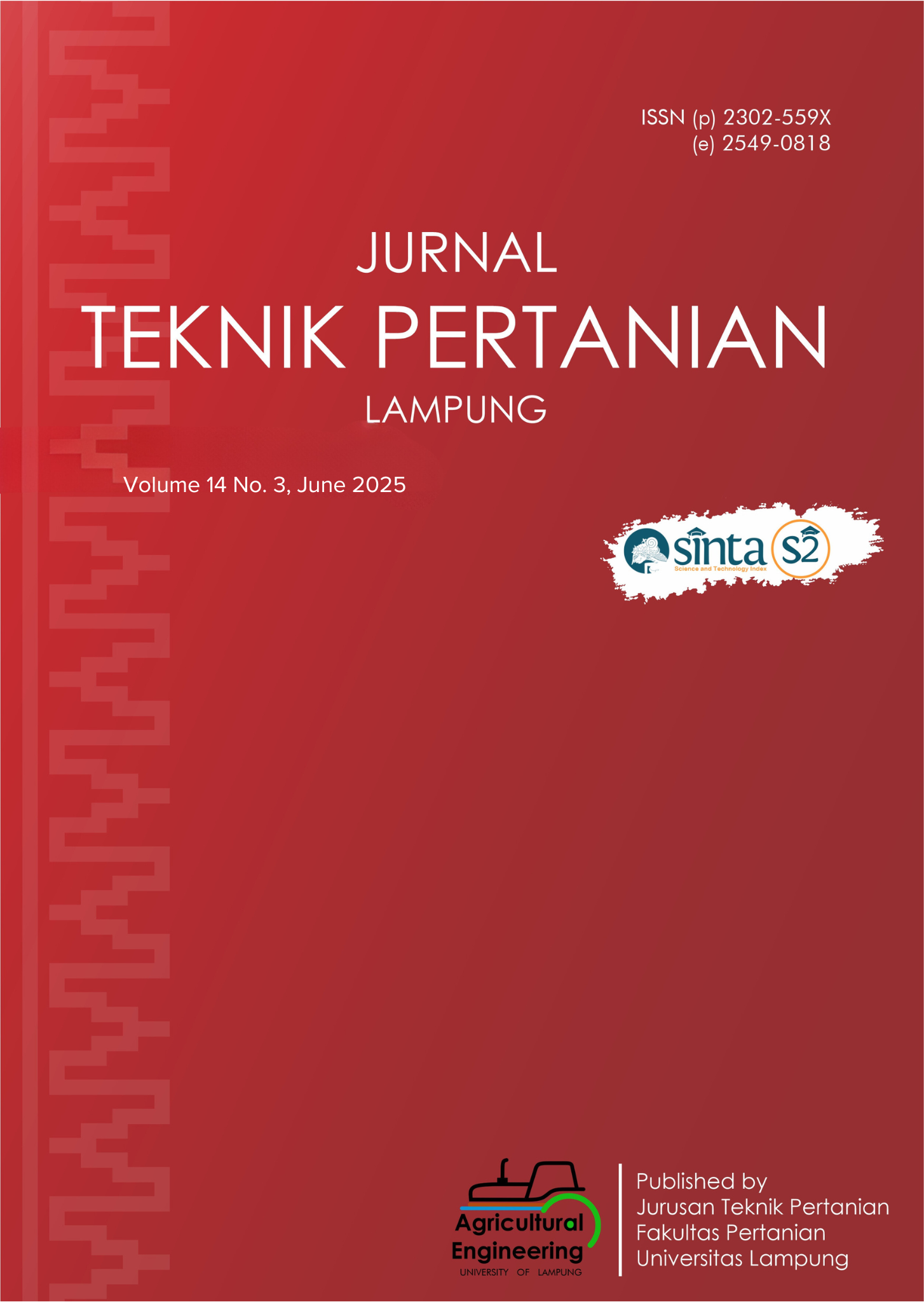Design and Technical Evaluation of a Tempeh Slicer Using Stainless Steel Rotating Disc with Three Curved Blades
DOI:
https://doi.org/10.23960/jtep-l.v14i3.920-932 Abstract View: 352
Abstract View: 352
Abstract
A tempeh chips slicing machine has been developed. This machine was developed based from the results of the previous research. The main slicing component is a stainless steel rotating disc equipped with three curved knives. With this knives geometry arrangement, slicing can be done at high speed. High speed is possible due to the absence of reciprocating motion and due to smooth cutting strokes. A variable speed 550W brush less direct current motor was employed to power the slicing mechanism. The machine was tested at motor speed of 500, 600, 700, 800 and 900 rpm. Across all speeds, the machine consistently produced chips of 1 mm thickness that is in compliance with industrial requirement. The machine produced up to 96% of intact slices, with slicing capacity of 53 kg/h (692 slices/min) and a very low electric power consumption ranged from 23 W (at 500 rpm) to 60 W (at 900 rpm). The machine can slice several chip solid materials with good results, therefore it has the potential to be developed into a multi purpose chip slicer.
Keywords: Curved rotary knife, Low power consumption, Slicer, Slicing machine, Tapioca tempeh chip.
Downloads
References
Agtriandy, Y., Istiasih, H., & Santoso, R. (2022). Mesin pengiris tempe otomatis sebagai bahan baku keripik tempe. Nusantara of Engineering (NOE), 5(2), 118–126. https://doi.org/10.29407/noe.v5i2.17596
Catherine, C., Eveline, E., Antony, V.S., & Juliana, J. (2022). Processed food creations made from tempeh. International Journal of Social and Management Studies, 3(5), 125–138.
Dharmawan, A., Alamsyah, R.A., Tasliman, T., & Soekarno, S. (2022). Rancang bangun dan uji kinerja mesin perajang keripik pisang dengan empat pisau horizontal. Teknotan: Jurnal Industri Teknologi Pertanian, 16(2), 79–84. https://doi.org/10.24198/jt.vol16n2.3
Fahrizal, F., Mau, S., Priyono, K.B., Suprapto, E., & Bianome, W.E. (2024). Disain dan evaluasi kinerja mesin pengiris ubi kayu pada berbagai kecepatan dan tebal pengirisan. Jurnal Pendidikan Teknik Mesin Undiksha, 12(1), 53–62. https://doi.org/10.23887/jptm.v12i1.75425
Garside, A.K., & Sudjatmiko, S. (2016). Rancang bangun mesin pengiris tempe multi fungsi pada UKM Sanan – Malang. Prosiding Seminar Nasional dan Gelar Produk SENASPRO 2016: 513–519.
Gere, J.M., & Timoshenko, S.P. (1991). Mechanics of Materials (3rd SI edition). Chapman & Hall, London, UK. Gibroni, M.G., Margianto, M., & Basjir, M. (2024). Perancangan mesin pengiris tempe dengan sistem transmisi pulley. Jurnal Teknik Mesin, 21(2), 38–41.
Handoko, M.B., Daulay, S.B., & Munir, A.P. (2018). Rancang bangun alat pengiris tempe mekanis tenaga penggerak 0,5 hp. Jurnal Rekayasa Pangan dan Pertanian, 6(4), 818–824.
Hariri, H., Fathar, M.A., & Bachtiar, I. (2022). Rancang bangun mesin pengiris tempe otomatis. Sintek Jurnal: Jurnal Ilmiah Teknik Mesin, 16(1), 30–40. https://doi.org/10.24853/sintek.16.1.30-40
Istiadi, I., Wardhani, A.R., Fadhillah, A.R., Putri, R.S., Wisnu, A.D.R., & Sari, Y.W. (2022). Peningkatan kapasitas proses produksi ukm keripik tempe melalui implementasi mesin pemotongan tempe. Jurnal Aplikasi dan Inovasi Ipteks Soliditas, 5(1), 175 180. https://doi.org/10.31328/js.v5i1.3468
Klebanov, B.M., Barlam, D.M., & Nystrom, F.E. (2008). Machine Elements: Life and Design. CRC Press, Boca Raton, Florida, Luthfi, F., Munir, A.P., & Panggabean, S. (2016). Rancang bangun alat pengiris tempe. Jurnal Rekayasa Pangan dan Pertanian, 4(4), 545–552.
Nifah, K., & Astuti, N. (2015). Pengaruh proporsi tepung (tapioka–tempe) dan metode pembuatan adonan terhadap sifat organoleptik dan fisik kerupuk tempe. E-Journal Boga, 4(3), 57–70.
Porawati, H., & Kurniawan, A. (2021). Mesin pengiris tempe semi otomatis jenis disc cutter vertical. Jurnal Inovator, 4(2), 36–39. https://doi.org/10.37338/inovator.v4i2.147
Pujiono, A., & Hindryanto, E. (2017). Perancangan dan pembuatan mesin pengiris tempe dengan sistem pisau berputar. Surya Teknika, 1(1), 15-27.
Putro, S. (2006). Perajang mekanik kripik. Media Mesin, 7(2), 55–62.
Rofarsyam, R. (2012). Rancang bangun mesin pengiris tempe sistem pisau berputar horizontal. Jurnal Penelitian Teknik Mesin, 7(3), 57–63.
Setiawan, F., Wicaksono, D., Rizki, I., Hillal, R.F., Widagdo, D., & Mahendra, D.A. (2024). Improving the production and managerial performance of tempeh chip MSMEs. Jurnal Inovasi Hasil Pengabdian Masyarakat (JIPEMAS), 7(1), 64–81. https://doi.org/10.33474/jipemas.v7i1.20989
Shurtleff, W., & Aoyagi, A. (2022). History of Tempeh and Tempeh Products (1815-2022) – Extensively Annotated Bibliography and Sourcebook. Soyinfo Center, Lafayette, CA, USA.
Tasliman, T. (2023). Rancang bangun mesin pengiris keripik tempe tapioka dengan pisau putar lengkung. Jurnal Teknologi Pertanian Andalas, 27(1), 83–93. https://doi.org/10.25077/jtpa.27.1.83-93.2023
Tasliman, T., Soekarno, S., Sutarsi, S., & Nadzirah, R. (2024). Peningkatan kapasitas produksi keripik tempe tapioka di UMKM “Bu Min” Jember dengan penerapan mesin pengiris tipe pisau lengkung. KIAT Journal of Community Development, 3(1), 47 52.
Utomo, A.P., & Nurlaila, Q. (2021). Perancangan mesin pengiris tempe semiotomatis dengan arah pengirisan horizontal. Profisiensi: Jurnal Program Studi Teknik Industri, 9(2), 252–261. https://doi.org/10.33373/profis.v9i2.3690
Wahyudi, A. (2018). Pengaruh variasi suhu ruang inkubasi terhadap waktu pertumbuhan Rhizopus oligosporus pada pembuatan tempe kedelai. Jurnal Redoks, 3(1), 37–44.
Wardianto, D., Hafni, H., & Perkasa, M.H. (2023). Pembuatan dan pengujian mesin perajang talas. Jurnal Teknologi dan Vokasi, 1(1), 31–37. https://doi.org/10.21063/jtv.2023.1.1.5
Yahya, M.K., Priambodo, P., & Supardi, S. (2022). Rancang bangun mesin pengiris tempe menggunakan pisau rotari dengan variasi putaran motor dan jumlah mata pisau. Publikasi Online Mahasiswa Teknik Mesin Universitas 17 Agustus 1945 Surabaya, 5(1).
Downloads
Published
How to Cite
Issue
Section
License
Authors who publish with this journal agree to the following terms:
Authors retain copyright and grant the journal right of first publication with the work simultaneously licensed under a Creative Commons Attribution-ShareAlike 4.0 International Lice that allows others to share the work with an acknowledgement of the work's authorship and initial publication in this journal.
Authors are able to enter into separate, additional contractual arrangements for the non-exclusive distribution of the journal's published version of the work (e.g., post it to an institutional repository or publish it in a book), with an acknowledgement of its initial publication in this journal.
Authors are permitted and encouraged to post their work online (e.g., in institutional repositories or on their website) prior to and during the submission process, as it can lead to productive exchanges, as well as earlier and greater citation of published work (See The Effect of Open Access).
Jurnal Teknik Pertanian Lampung

JTEPL is licensed under a Creative Commons Attribution-ShareAlike 4.0 International License.













